A Comprehensive Guide to Generative AI Applications for Document Extraction
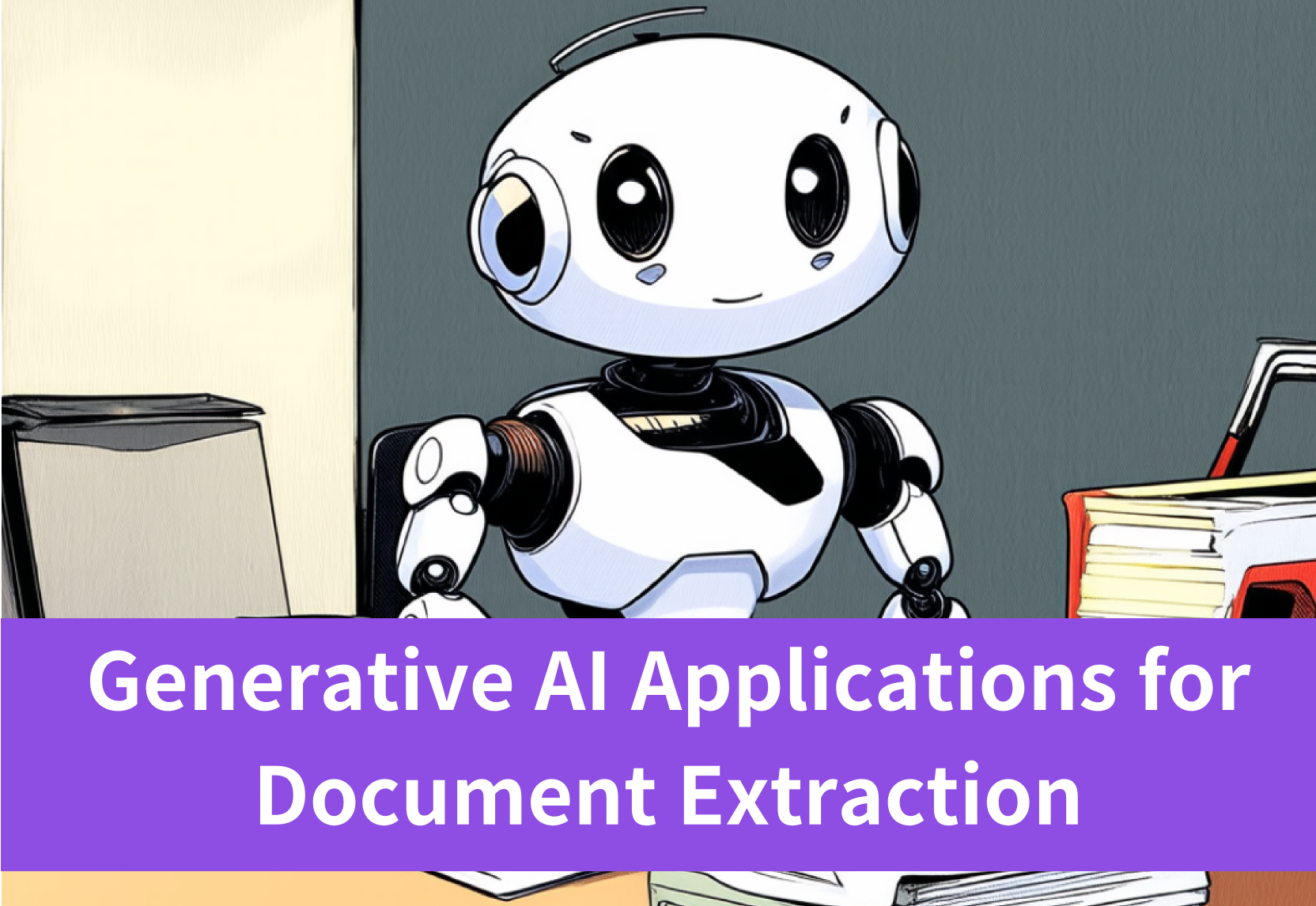
Key Highlights
- Market Potential: Generative AI is projected to grow to $1.3 trillion by 2032, driven by AIaaS, digital ads, and AI assistants.
- IDP Market Insights: The IDP market will expand from $1.75 billion in 2023 to $19.32 billion by 2032, with a focus on digital transformation and AI technologies.
- Generative AI Applications: Text Summarization; Data Extraction; Content Categorization; Language Translation.
- Advantages: Accuracy; Speed; Scalability; Adaptability.
- Popular Tools: ABBYY; Rossum; AntWorks; Hyperscience; qBotica; Automation Anywhere.
- Technical Essentials: GPU Instances; LLM APIs; Data Infrastructure: ; NLP Tools; OCR.
Introduction
In an era marked by rapid technological advancements, generative AI has emerged as a game-changer in the field of document extraction. The market potential for generative AI is vast, with projections indicating it could soar to $1.3 trillion by 2032, driven by the growing demand for AI-as-a-Service (AIaaS), digital advertising innovations, and sophisticated AI assistant software. Alongside this, the intelligent document processing (IDP) market is witnessing significant growth, fueled by the need for digital transformation and the integration of AI and machine learning technologies.
This comprehensive guide explores the transformative power of generative AI applications for document extraction, highlighting its applications, advantages, and the technical essentials required to build robust AI solutions.
Market Potential of Gen AI
The Bloomberg Intelligence report predicts an explosive growth in the generative AI market, forecasting it to reach $1.3 trillion by 2032, up from just $40 billion in 2022. This significant expansion is expected to occur at a compound annual growth rate (CAGR) of 42% over the next decade. Key drivers of this growth include generative AI infrastructure as a service (AIaaS) for training large language models, digital ads powered by generative AI technology, and specialized AI assistant software. The hardware side will also see substantial revenue, with AI servers, AI storage, computer vision AI products, and conversational AI devices leading the way.
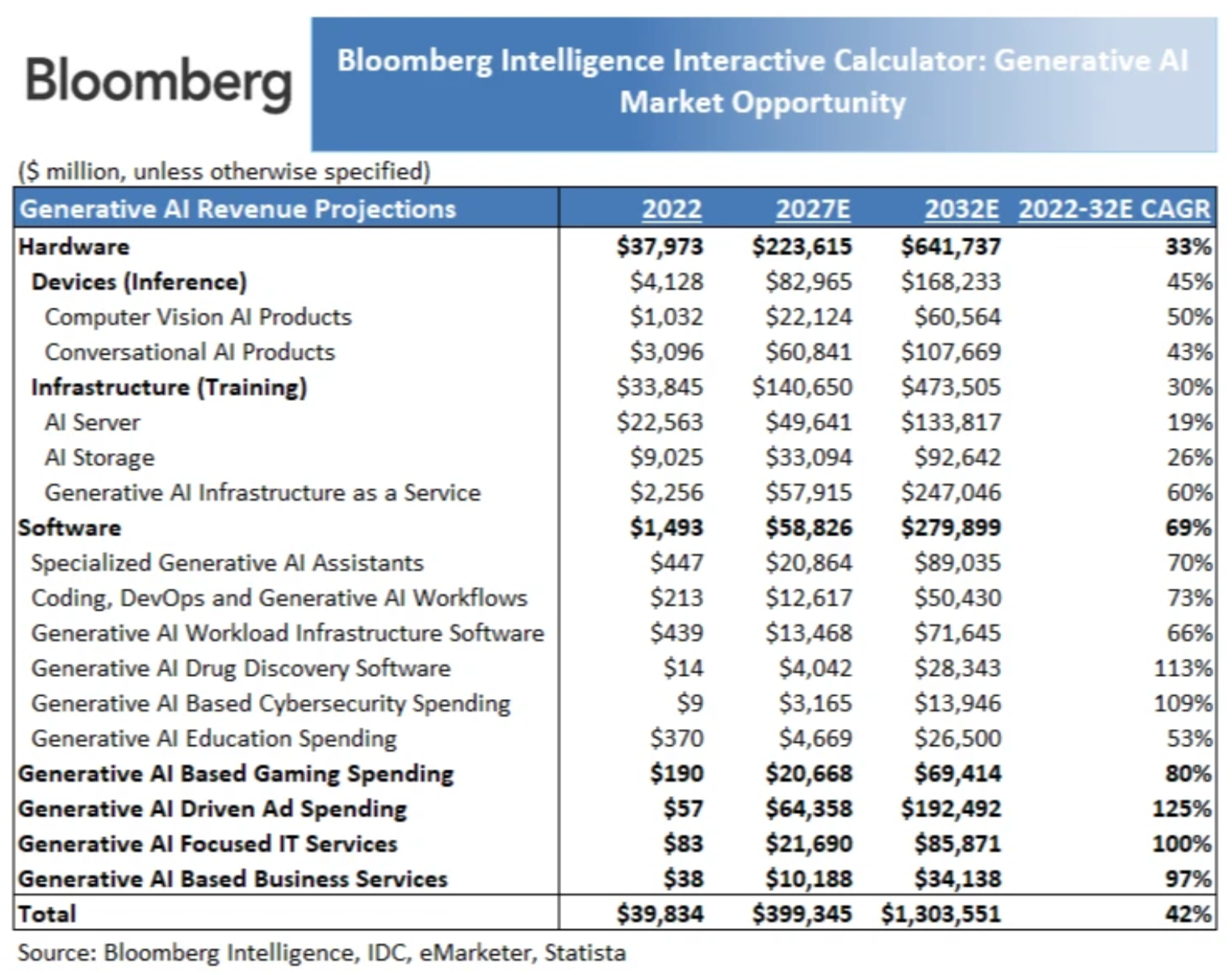
The report further highlights the potential for generative AI to transform sectors such as life sciences and education, with early use cases indicating rapid growth in these areas. Companies like Amazon Web Services, Microsoft, Google, and Nvidia are poised to benefit significantly as enterprises increasingly shift their workloads to the public cloud. This technological revolution is set to become an integral part of IT spending, ad spending, and cybersecurity, fundamentally changing the way the technology sector operates and potentially disrupting incumbents across various industries.
Intelligent Document Processing Market Analysis
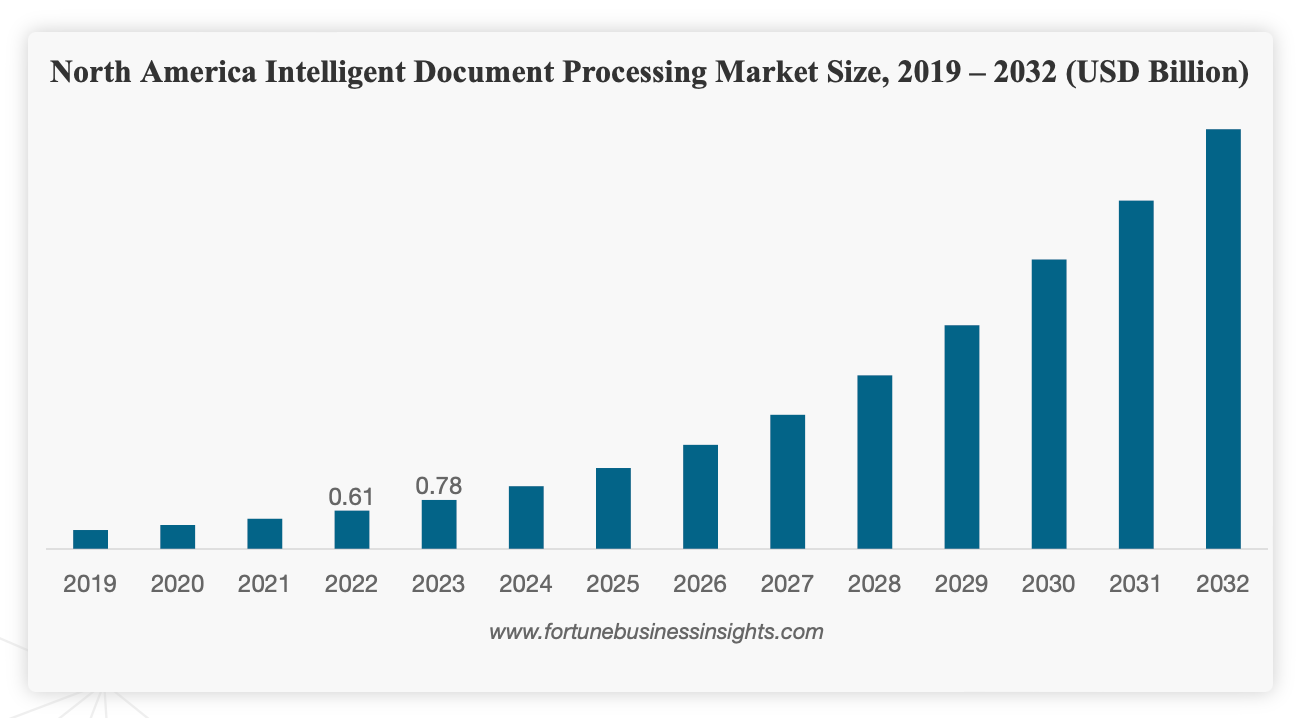
Based on Fortune Business Insights report, here is a summary of the key points regarding the market potential of intelligent document processing (IDP), or Generative AI for Document Extraction:
Market Size and Growth
The global intelligent document processing (IDP) market was valued at USD 1.75 billion in 2023 and is projected to grow to USD 19.32 billion by 2032, exhibiting a CAGR of 30.5% during the forecast period (2024–2032). This growth is attributed to the increasing focus on digital transformation, efficient document management, and the growing adoption of AI and ML technologies for business processes.
Technological Advancements
IDP uses technologies such as Natural Language Processing (NLP), Optical Character Recognition (OCR), computer vision, and Machine Learning (ML) to extract and classify documents. The demand for IDP is driven by the need to reduce manual efforts and discover insights in structured and unstructured documents.
Industry Applications
Industries like BFSI, healthcare, and manufacturing, which deal with a large number of text documents daily, are turning to IDP to efficiently process large volumes of structured and unstructured data. The insurance industry, for example, handles more than 100 million documents annually, making IDP a crucial tool for managing such volumes.
Digital Transformation
The COVID-19 pandemic accelerated digital transformation across various industries due to social distancing measures and government-imposed restrictions. Businesses have increasingly adopted digital technologies, making IDP a key tool in their digital transformation journey.
Automated Data Extraction
Generative AI has reshaped IDP by automating data extraction and understanding complex document structures through NLP and computer vision. This technology enables organizations to streamline document-intensive processes, reduce manual efforts and errors, and accelerate decision-making processes.
Market Growth Factors
The increasing need for automated document management is a significant factor driving market growth. Manual data entry errors in supply chain and procurement functions cost businesses over USD 600 billion annually, making the adoption of IDP crucial for reducing these costs.
Restraining Factors
Data security concerns and the challenge of handling unstructured data pose significant challenges to the widespread adoption of IDP. Ensuring robust security measures and advanced AI models to extract insights from unstructured documents are essential for overcoming these hurdles.
Market Segmentation
The market is segmented by function, deployment model, enterprise type, and industry. The finance & accounting function segment is expected to hold the largest market share, while the supply chain & procurement function segment is expected to show the highest CAGR.

Regional Insights
North America is expected to account for the largest market share due to the presence of well-established players and technological advancements. The Asia Pacific market is expected to show the highest growth rate due to the presence of fast-growing economies and the rapid adoption of digital technologies.
Key Generative AI Applications for Document Extraction
Text Summarization
Generative AI excels at summarizing extensive documents, distilling them into concise versions that capture the essential points.
Data Extraction
AI can automatically extract critical information, such as names, dates, and other pertinent details from documents.
Content Categorization
Generative AI can categorize content into predefined or dynamically created categories. This helps in organizing information systematically.
Language Translation
AI-powered translation tools can convert documents into multiple languages, preserving the original context and meaning.
Advantages of Using Generative AI for Document Extraction
Accuracy
Generative AI significantly enhances the accuracy of document extraction compared to traditional methods. By leveraging advanced machine learning algorithms, AI can precisely identify and extract relevant information, reducing errors and ensuring high-quality data retrieval.
Speed
One of the standout benefits of generative AI is its ability to expedite the document extraction process. AI can process large volumes of documents in a fraction of the time it takes manually, enabling faster decision-making and more efficient workflows.
Scalability
AI solutions are inherently scalable, capable of handling increasing amounts of data without compromising performance. As data needs grow, generative AI systems can easily adapt, making them ideal for businesses that anticipate expansion or fluctuating document volumes.
Adaptability
Generative AI is highly adaptable, able to work with various document formats and types. Whether dealing with text files, PDFs, emails, or other formats, AI can seamlessly extract and process information, providing a versatile solution for diverse document management needs.
Popular Generative AI Applications for Document Extraction
ABBYY

ABBYY uses innovative AI models to transform any document from any source to any process. Moreover, it transforms enterprise processes and data with purpose-built AI solutions — created from over 35 years of industry experience.
Rossum

Rossum automates 99% of transactional workflows with AI document processing. It is the AI-first, cloud-native platform that will automate the entire transactional document process end to end.
AntWorks

CMR+, AntWorks’ World Class Enterprise Scale Low Code AI Powered IDP Platform, is the ultimate Intelligent Document Processing platform that helps global enterprises streamline operations, extract insights, and make data-driven decisions with ease.
Hyperscience

Powered by industry-leading ML, the Hyperscience Platform is powerful and flexible enough to automate any type of document process from input to actionable data with ease.
qBotica

qBotica offers automation as a Service (AaaS) & Specialized AI Services that will drive revenue, retain customers, and lower operations costs.
Automation Anywhere
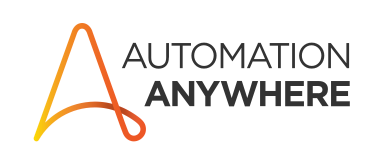
Document Automation for Automation 360 Cloud and On-Premises provides generative AI (GenAI) capability to extract data seamlessly from unstructured and semi-structured documents without prior training.
Technical Essentials of Building Generative AI Applications for Document Extraction
Building generative AI applications for document extraction requires a solid foundation of technical components and tools. Here are the key essentials:
1. High-Performance Computing Resources:
GPU Instances: For training and deploying AI models, high-performance GPU instances are crucial. GPUs accelerate the processing of large datasets and complex computations involved in generative AI.
Novita AI GPU Instance is a leading cloud-based solution. It features high-performance GPUs such as the NVIDIA A100 SXM and RTX 4090, making it especially advantageous for PyTorch users who need extra computational power without the expense of investing in local hardware.

This cloud infrastructure offers flexibility and scalability, enabling users to select from various GPU configurations tailored to their specific project requirements. Novita AI GPU Instance supports a range of software options and operates on a pay-as-you-go basis, significantly reducing costs.

Cloud Platforms: Platforms like AWS, Google Cloud, and Azure offer scalable GPU instances that can be provisioned based on the computational needs.
2. Large Language Models (LLMs) and APIs:
Pre-trained Models: Utilize pre-trained language models such as GPT-4, BERT, or T5 that can be fine-tuned for document extraction tasks.
LLM APIs: Leverage APIs from providers like Novita AI to integrate powerful language models into your application without the need for extensive in-house training.
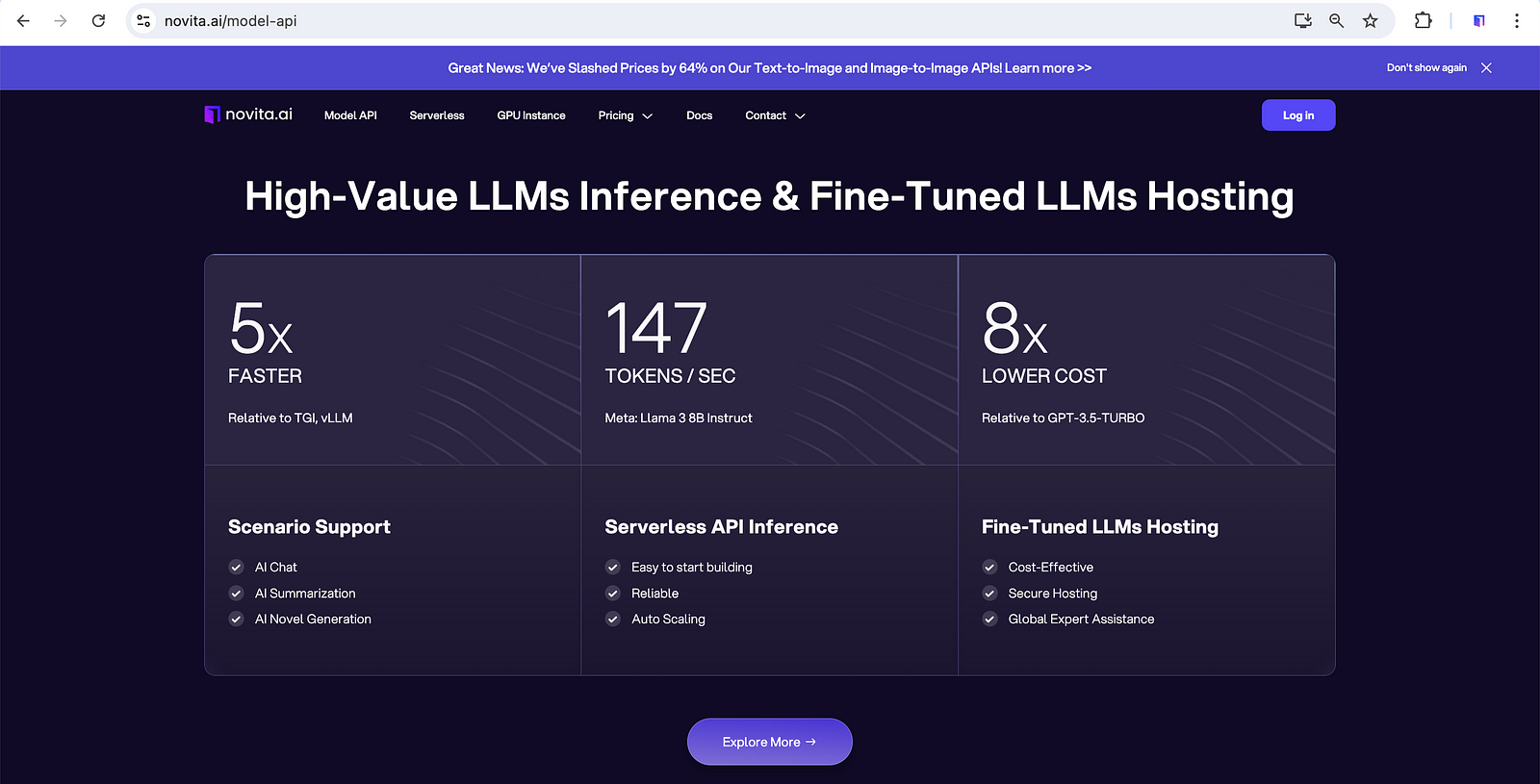
Novita AI LLM API provides you with reliable, scalable, and cost-effective LLM solutions. The models available are deployed for industry-leading speeds to excel at production tasks, and they enhance role-play, spark engaging discussions, and foster creativity, with content compatibility that is not subject to restrictions.
We just released Meta’s newest models, including meta-llama-llama-3.1–405b-instruct. You can explore more model options on Novita AI Playground.

3. Data Infrastructure:
Data Storage: Implement robust data storage solutions to manage large volumes of documents. Solutions like Amazon S3, Google Cloud Storage, and Azure Blob Storage offer scalable and secure options.
Data Pipelines: Establish data pipelines for preprocessing, cleaning, and formatting documents before feeding them into AI models. Tools like Apache Airflow and AWS Glue can automate these processes.
4. Machine Learning Frameworks:
Frameworks: Utilize machine learning frameworks such as TensorFlow, PyTorch, and Hugging Face Transformers for developing and training generative AI models.
Libraries: Incorporate libraries like SpaCy for natural language processing tasks and NLTK for text processing.
5. Model Training and Fine-tuning:
Custom Training: Fine-tune pre-trained models on specific datasets to improve performance on document extraction tasks.
Transfer Learning: Employ transfer learning techniques to adapt existing models to new domains with limited data.
6. Natural Language Processing (NLP) Tools:
Tokenization: Use NLP tools for tokenizing text, which is the process of breaking down text into smaller units (tokens) for easier analysis.
Named Entity Recognition (NER): Implement NER to identify and extract entities like names, dates, and locations from documents.
7. Optical Character Recognition (OCR):
OCR Tools: For extracting text from scanned documents or images, integrate OCR tools like Tesseract, Google Cloud Vision, or Amazon Textract.
8. APIs and Integration:
RESTful APIs: Develop RESTful APIs for integrating the document extraction capabilities into existing applications and workflows.
Webhook and Event-driven Architectures: Use webhooks and event-driven architectures to trigger document extraction processes automatically based on predefined events.
9. Security and Compliance:
Data Encryption: Ensure data is encrypted both at rest and in transit to maintain security and compliance with regulations.
Access Control: Implement role-based access control (RBAC) to restrict access to sensitive data and functionalities.
10. Monitoring and Maintenance:
Performance Monitoring: Use tools like Prometheus and Grafana to monitor the performance of AI models and infrastructure.
Model Retraining: Establish a retraining schedule to keep models up-to-date with the latest data and improve accuracy over time.
Future Trends in Generative AI and Document Extraction
1. Advanced Neural Network Architectures
The development of more sophisticated neural network models will enhance the ability of generative AI to understand and produce human-like text, improving the accuracy and reliability of document extraction.
2. Increased Automation
There will be a greater push towards automating document-intensive processes across various industries, reducing the need for manual data entry and improving efficiency.
3. Enhanced Data Security Measures
As document extraction often involves sensitive information, the implementation of advanced security protocols and encryption methods will be crucial to protect data privacy.
4. Greater Focus on Ethical AI
With the rise of generative AI, there will be an increased emphasis on developing ethical guidelines to prevent biases in AI algorithms and ensure fair and transparent AI operations.
5. Adoption of Cloud-based Solutions
The shift towards cloud computing will continue to grow, offering scalable and cost-effective solutions for document processing that can be accessed from anywhere.
6. Specialized AI-based Software Assistants
The development of AI-based assistants tailored for specific industries or functions, such as legal, financial, or medical document processing, will become more common.
7. Generative AI for Knowledge Management
Organizations will increasingly use generative AI to create knowledge repositories by extracting and summarizing information from vast amounts of documents, improving information retrieval and decision-making.
8. Regulatory Compliance and Standardization
As generative AI becomes more integral to business processes, there will be a push for regulatory compliance and standardization to ensure the technology is used responsibly and effectively.
9. Personalized Content Creation
Generative AI will be used to create personalized content for marketing, customer service, and other areas, enhancing customer engagement and satisfaction.
10. Cross-industry Applications
While currently prominent in sectors like finance and healthcare, generative AI for document extraction will expand into other industries, including manufacturing, retail, and government services.
11. User Experience Improvement
The user interface and experience of document processing tools will become more intuitive, allowing non-technical users to leverage the power of generative AI with ease.
Conclusion
As generative AI continues to evolve, its impact on document extraction will only become more profound. The technology promises to enhance accuracy, speed, scalability, and adaptability, making it an invaluable tool for businesses dealing with large volumes of documents. With its ability to automate data extraction, summarize content, and facilitate multilingual translation, generative AI is set to revolutionize how organizations manage and utilize their data. As we look to the future, advancements in AI technologies and increased adoption of cloud-based solutions will drive further innovation, offering new opportunities and addressing emerging challenges.
FAQs
What are the common applications of generative AI?
- Text Generation and Summarization.
- Image Creation and Editing.
- Chatbots.
- Translation.
- Creating music.
- Editing videos and adding special effects.
- Enhancing gaming experiences.
- Developing virtual reality applications.
- Utilizing pre-built tools and frameworks.
- Producing realistic, human-like voices.
- Detecting fraud in real-time.
- Offering personalized banking services.
What is document parsing using GenAI?
By utilizing parsing, GenAI can automatically retrieve essential information from multiple document formats, such as text files, PDFs, and emails.
Novita AI is the All-in-one cloud platform that empowers your AI ambitions. Integrated APIs, serverless, GPU Instance — the cost-effective tools you need. Eliminate infrastructure, start free, and make your AI vision a reality.
Recommended Reading
LLM vs Generative AI: What is the difference
HR Chatbot: Trends and Examples for Success
10 Chatbot Best Practices for Successful Automation